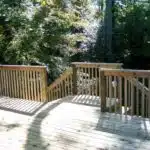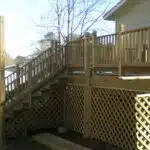As a deck building and installation expert, I have encountered numerous clients who have expressed their concerns about the safety of their decks. One of the most frequent requests I receive is on how to build a deck gate. A gate is an essential component of any deck as it provides security for children, pets, and anyone else who may be using the space.
Building a deck gate may seem like a daunting task; however, with the right tools and materials, it can be accomplished with relative ease. In this article, I will guide you through the step-by-step process of building a sturdy and secure deck gate that will keep your loved ones safe while also complementing the aesthetic appeal of your outdoor living space. Whether you are an experienced DIY enthusiast or a novice builder, this article will provide you with all the necessary information needed to build a functional and beautiful deck gate.
Assessing Your Needs For A Deck Gate
As a deck building and installation expert, it is important to assess the safety needs of your deck before deciding on gate design ideas. Assessing safety involves considering factors such as the height of your deck, the presence of children or pets in your household, and any local building codes that dictate gate requirements. These considerations will inform both the design and materials used for your deck gate.
Gate design ideas can range from simple and functional to elaborate and decorative. However, when assessing your needs for a deck gate, it is important to prioritize safety over aesthetics. A gate that is too low, too flimsy, or too difficult to secure can pose a risk to both people and pets using the deck. That being said, there are many ways to create a safe and visually appealing deck gate, such as incorporating matching materials or decorative elements that complement the overall style of your deck.
In addition to assessing safety and design needs, it’s important to consider practical issues such as ease of use when planning your deck gate. Factors such as location (e.g., stairs vs. flat surface), frequency of use (e.g., daily vs. occasional), and user abilities (e.g., small children vs. adults) should all be taken into account when choosing a gate style that will work best for you and your family’s needs. By carefully considering these factors at the outset of the project, you can ensure that your new deck gate will not only be safe but also user-friendly and aesthetically pleasing.
Assessing safety considerations, prioritizing functionality over aesthetics in choosing gate design ideas, and thoroughly evaluating practical issues such as location and frequency of use are all key steps in creating an effective deck gate solution for your home. With these factors in mind, we can now move onto measuring for the gate itself in order to ensure a successful installation process.
Measuring For The Gate
Assessing your needs for a deck gate is crucial in determining the size and type of gate you need. The next step is to measure accurately for the gate. Measuring accuracy is important because it ensures that the gate fits perfectly and functions properly.
To begin, determine the width of the opening where the gate will be installed. Measure from post to post, making sure to take into account any obstructions such as railings or stairs. It’s essential to measure both at the top and bottom of the opening as they may differ due to uneven surfaces.
Adjusting for uneven surfaces is another critical aspect when measuring for a deck gate. If your deck has an uneven surface, it’s best to take multiple measurements at different points along the opening and use an average measurement to ensure a precise fit. Once you have your accurate measurements, you can move on to choosing the right materials for your new deck gate.
Choosing The Right Materials
When constructing a deck gate, it is important to consider the durability, cost, maintenance, and weather resistance of the materials used. Additionally, style, color, size, and fasteners should be taken into account. Furthermore, the foundation, lumber type, stain/paint, hardware, posts, supports, and screws should be chosen to ensure the longevity of the deck gate. Ultimately, selecting the right materials can help to ensure a successful installation.
Durability
When it comes to building a deck gate, choosing the right materials is crucial for ensuring its durability. The gate will be exposed to various weather conditions and constant usage, which can lead to wear and tear over time. Therefore, long-term maintenance should be a top consideration when selecting materials.
One important factor to consider is weather resistance. Look for materials that can withstand harsh elements such as rain, snow, and extreme temperatures. Materials like vinyl or aluminum are great options as they require little maintenance and are highly resistant to damage caused by weather.
Another consideration for durability is long-term maintenance. Even if you choose the most durable material available, proper maintenance is still necessary for prolonging its lifespan. Regular cleaning and inspections can help identify any potential issues before they become major problems. With the right materials and proper upkeep, your deck gate can provide reliable security for years to come without sacrificing its appearance or functionality.
Cost
When it comes to building a deck gate, choosing the right materials is just one part of the process. Another crucial consideration is the cost of the materials and how they fit into your overall budget. Depending on your needs and preferences, there are various options available that can help you achieve a balance between durability and affordability.
One cost-saving tip is to consider using wood as your primary material. While wood may not be as weather-resistant as vinyl or aluminum, it can still provide reliable security for your deck gate at a more affordable price point. Additionally, by selecting high-quality wood and properly treating it with sealant or stain, you can extend its lifespan and minimize maintenance costs over time.
Another way to save on costs is to do some of the work yourself. If you’re handy with tools and have experience with DIY projects, you may be able to save money by installing the gate yourself rather than hiring a professional. Just be sure to carefully follow all safety guidelines and instructions when working with power tools or heavy materials like wood or metal. With these cost-saving tips in mind, you can choose the right materials for your deck gate without breaking the bank.
Tools Required For Building A Deck Gate
When building a deck gate, it’s important to have the right tools on hand to ensure that the job is done safely and efficiently. While some homeowners may be tempted to work with whatever they have on hand, using the proper measuring techniques and safety equipment can help prevent injuries and ensure that the gate fits perfectly within its intended space.
To get started, be sure to gather all of the necessary tools before beginning work on your deck gate. This should include items like a measuring tape, circular saw, drill, screws, safety goggles, gloves, and ear protection. These tools will help you measure accurately and make clean cuts without putting yourself at risk for injury.
When it comes to measuring techniques for your deck gate, accuracy is key. Be sure to measure both the width and height of your gate opening before cutting any materials. Additionally, take into account any unusual angles or slopes in your deck design that may affect the placement or positioning of your gate.
Next up: planning the placement of the gate. By taking things one step at a time and using proper measuring techniques and safety equipment along the way, you can build a beautiful and functional deck gate that will last for years to come.
Planning The Placement Of The Gate
- When planning the placement of the gate, the location should be determined first and foremost.
- To ensure optimal use of the deck space, measurements of the desired gate area should be taken.
- The measurements should take into account the size of the gate, the space needed for its opening and closing, and any other potential obstructions.
- Consideration should also be given to the intended use of the gate and the ease of access it will provide.
Determining Location
When it comes to planning the placement of a deck gate, determining its location is crucial. This step involves careful consideration of design and safety requirements to ensure that the gate serves its intended purpose effectively. Design considerations include the size and shape of the gate, as well as its overall style and aesthetic appeal. Safety requirements, on the other hand, involve assessing potential hazards in the surrounding area such as stairs or uneven surfaces.
One important factor to consider when determining the location of a deck gate is accessibility. The gate should be placed in a position that allows easy access for those who will be using it frequently. If the deck has multiple entry points, it may be necessary to install more than one gate to ensure convenient access from all sides. Additionally, if there are any obstacles in the way such as furniture or outdoor equipment, these should also be taken into account when deciding where to place the gate.
Another aspect to consider when planning the placement of a deck gate is visibility. The gate should be easily visible from both inside and outside of the deck area to prevent accidents or injuries. This can be achieved by selecting a brightly colored or contrasting material for the gate or installing additional lighting around it. Overall, determining the location of a deck gate requires thoughtful consideration of design and safety factors to ensure that it serves its intended purpose effectively and efficiently.
Measuring Space
When planning the placement of a deck gate, it is important to consider the available space. Measuring the space accurately helps in determining the appropriate size and style of the gate that will fit well into the designated location without disrupting any other deck features. Deck gate design often incorporates space-saving techniques such as sliding or swinging gates that require less room to operate.
Measuring space also ensures that the gate is installed at an appropriate height. The ideal height for a gate depends on its intended use, but generally, gates should be tall enough to prevent children and pets from climbing over, yet low enough to allow easy access for adults. Measuring the height of the surrounding railings and any other obstacles will help determine where to place the gate so that it fits seamlessly into its environment.
Furthermore, measuring space helps ensure compliance with local building codes and regulations regarding safety requirements for decks and outdoor structures. A properly measured and placed deck gate can help prevent accidents, injuries, or falls from heights. Therefore, it is essential to work with a professional contractor who understands these safety requirements and can provide expert guidance during the planning process.
Creating A Blueprint For The Gate
The next step in building a deck gate is creating a blueprint for the gate. Before starting, it’s important to consider design elements such as the height and width of the gate, as well as any decorative features that may be desired. It’s also important to choose the right gate hardware options, such as hinges and latches, that will ensure durability and ease of use.
When creating a blueprint for the gate, it’s important to take accurate measurements of the opening where the gate will be installed. The materials used for the gate should also be taken into consideration when determining its dimensions. For example, if using wooden planks for the gate, it’s important to determine how many planks will be needed and their sizes.
Gate hardware options are also an important consideration when creating a blueprint for a deck gate. Gate hinges should be chosen based on their weight capacity and ability to withstand outdoor elements. Latches should also be chosen carefully based on security needs and ease of use. By carefully considering all design elements and hardware options, you can create a blueprint that ensures your deck gate is both functional and aesthetically pleasing.
Moving forward, cutting the wood for the gate requires precision to ensure that all pieces fit together properly.
Cutting The Wood For The Gate
As you begin to cut the wood for your deck gate, it is important to consider the design of your gate carefully. Your gate should complement the overall look and feel of your deck while also serving its primary function of providing access control. Therefore, before cutting any wood, ensure that you have a clear understanding of what dimensions and style you want your gate to have.
In terms of wood cutting techniques, it is essential to use the right tools for the job. To make straight cuts, you will need a circular saw or a miter saw with a fine-toothed blade. For curved cuts or notches, a jigsaw can be used. When measuring and marking out your cuts, use a carpenter’s pencil and square to ensure accurate and precise measurements. Double-check all measurements before making any cuts.
Finally, when cutting the wood for your gate, remember that each piece must fit perfectly into place so that your gate operates effectively. This means using precise measurements and taking care not to remove too much material while cutting. Once all pieces are cut to size, sand them smooth using sandpaper or an electric sander. With careful planning and execution in mind, you are now ready to proceed with assembling the frame of your gate.
Transition: With all necessary precautions taken in designing and cutting your wood pieces with precision, it is now time to assemble the frame of your deck gate.
Assembling The Frame Of The Gate
The next step in building a deck gate is assembling the frame. The gate design will determine the type of lumber needed for the project. Choose the lumber that best suits the gate design and complements your deck’s aesthetic.
Next, attach the gate hardware to the frame. Gate hardware comes in various shapes and sizes, so it is essential to choose hardware that is appropriate for your gate’s size and weight. Common types of gate hardware include hinges, latches, and handles. Use screws or bolts to attach the hardware securely to the frame.
Now that you have assembled the frame and attached gate hardware, it is time to add some finishing touches. Sand down any rough edges or uneven surfaces with sandpaper or a power sander. Apply a wood sealer or paint to protect the wood from weather damage and add some color to your deck gate. Finally, ensure that all components are properly aligned before installing it on your deck.
To evoke emotion in our audience, consider these tips:
- A well-built deck gate not only adds beauty but also provides safety for your family and pets.
- Imagine taking in breathtaking views from your deck while knowing that your little ones are safe behind a sturdy gate.
- A custom-built deck gate can elevate the look of your outdoor space while providing peace of mind.
- With proper maintenance, a well-built deck gate can last for years without needing replacement.
In preparation for attaching the deck gate hinges, ensure that you have all necessary tools and equipment on hand before starting this next step.
Attaching The Deck Gate Hinges
Having assembled the frame of your deck gate, the next step is to attach the hinges. Properly installing hinges ensures that your gate will open and close smoothly without any squeaks or resistance. Before attaching the hinges, make sure they are the right size and type for your gate. This means choosing hinges that can support the weight of your gate and fit securely onto both the gate and the post.
To begin attaching the hinges, mark where you want them to go on both the gate and post using a pencil or marker. Once marked, drill pilot holes for each screw to prevent splitting wood. When drilling, be careful not to drill too deep as this may weaken the wood around it. After drilling pilot holes, align each hinge with its corresponding marks on both sides of the gate and post before screwing them in place.
Once all hinges are attached, adjusting tension is important to ensure that your gate hangs properly and opens smoothly. To do this, loosen or tighten screws on one or more of the hinges until you achieve proper tension. Choosing the right screws is also crucial in ensuring that your hinges stay securely fastened. Use screws that are long enough to penetrate through both pieces of wood but not so long that they protrude out from either side.
With the hinges now attached and properly adjusted, it’s time to move onto installing the latch. The latch secures your deck gate when closed, keeping children and pets safe while also providing privacy if desired. In order to install a latch correctly, you’ll need to choose a location that ensures it lines up with its corresponding piece on either side of the gate.
Installing The Latch
Choosing the right latch is crucial when building a deck gate. It is important to consider various factors such as ease of access and security. There are different types of latches available in the market, each with its own set of advantages and disadvantages.
The most common type of latch used for deck gates is the self-closing spring-loaded latch. This type of latch automatically closes the gate and can be locked with a padlock. It works well for families with pets or young children who may forget to close the gate behind them. However, it may not be ideal for those who want to keep their gate open for extended periods or have guests coming in and out frequently.
Another option is the thumb latch that requires manual operation to open and close the gate. It provides extra security but may not be suitable for those with limited mobility or small children who cannot reach it. A third option is the magnetic latch, which uses magnets to hold the gate closed securely. It is easy to operate and install but may not withstand heavy winds.
In summary, choosing a latch largely depends on personal preferences and specific needs. Each type has its own pros and cons, so it’s essential to weigh them carefully before making a decision on which one to install on your deck gate. Once you’ve made your choice, you can move on to sanding and finishing your gate for a polished look that complements your outdoor space seamlessly.
Sanding And Finishing The Gate
According to a recent survey conducted by the American Wood Protection Association, applying sealer on wooden gates can extend their lifespan significantly. This means that your deck gate will last longer and remain in good shape with proper sanding and finishing techniques. Applying sealer not only protects the wood from moisture and UV damage but also enhances its natural beauty.
Before applying any sealer, it is crucial to sand the gate properly. Start with a rough-grit sandpaper and work your way up to a fine-grit one for a smooth finish. Be sure to remove all dust particles using a tack cloth or vacuum cleaner before proceeding to apply any sealer. A good rule of thumb is to apply two coats of sealer, allowing each coat to dry completely before adding the next one.
Staining techniques can also be used to add color and character to your gate. When choosing the stain, consider both the color of your deck and the type of wood you are using for the gate. A lighter stain will give a more natural look while darker stains offer a more dramatic effect. Remember to test the stain on a small section first before applying it on the entire surface of the gate. Once you have achieved your desired look, let it dry completely before proceeding with sealing.
With your gate sanded, sealed, and stained, you are now ready for mounting.
Mounting The Gate
Now that you have successfully attached the gate hinges to your deck, it is time to mount the gate onto the hinges. Before proceeding, consider some safety concerns. Ensure that the gate is securely fastened and there are no loose screws or nails that could cause it to come apart. Also, make sure that the gate height meets local building codes and does not pose a hazard to children or pets.
Next, determine which way you want your gate to swing. A gate can swing inward or outward depending on your preference and space availability. Once you have decided on the swing direction, attach the latch to the opposite side of where the hinges are mounted. This will allow for easy opening and closing of the gate. Additionally, ensure that there is enough clearance between the ground and bottom of your gate so it can open and close smoothly without scraping against any obstacles.
After mounting your deck gate onto its hinges, test its functionality by swinging it back and forth a few times. Check that it opens easily and closes smoothly without any obstructions or resistance. If there are any issues with how your gate operates, such as sticking or not latching properly, double-check all screws and bolts for tightness and adjust as needed until you achieve proper function. Now that your deck gate is securely installed, proceed with confidence knowing you have taken all necessary precautions for safe use!
Testing The Gate
Metaphorically speaking, a deck gate is the protective shield to your deck. For it to serve its purpose, it should be tested for durability and security features. Testing the gate can be done in three simple steps.
Firstly, check if the gate can withstand pressure by pushing or pulling it. The hinges should be sturdy enough to support the weight of the gate without wobbling or sagging. This ensures that the gate is safe and secure for anyone passing through.
Secondly, test if the latch or lock mechanism works effectively. The latch should easily open and close without any resistance or difficulty, while also staying securely locked when shut. This enhances the security features of your deck gate.
Thirdly, examine if there are any gaps between the gate and its frame. Any gaps could compromise its security as they allow small animals such as rodents easy access to your deck area. It’s important to ensure all gaps are sealed off completely.
It’s important to ensure that your deck gate remains durable and secure over time. In order to do this, proper maintenance is required which includes regular cleaning and inspections for wear and tear. By doing so, you can guarantee that your deck gate will remain a reliable protection feature for years to come.
Maintaining Your Deck Gate
- Cleaning your deck gate regularly is important to keep it looking its best and to prevent the accumulation of dirt, moss, and grime.
- Sealing your deck gate will help protect it from the elements and keep it looking new for longer periods of time.
- Repairs to the deck gate should be made as soon as possible to prevent further damage and to ensure the safety of those using the gate.
- In order to clean a deck gate, use a pressure washer to remove dirt and debris from the surface.
- Sealing a deck gate should be done with a high-quality sealant that is designed for exterior use.
- Repairs to a deck gate should only be done by a professional deck builder or installation expert.
Cleaning
Maintaining your deck gate is essential to ensure its longevity and functionality. One of the most critical aspects of maintaining your deck gate is regular cleaning. A clean deck gate not only enhances the overall aesthetic of your outdoor space, but it also prevents dirt buildup that can lead to deterioration and damage.
Cleaning tips for a deck gate are simple and easy to follow. Firstly, remove all debris, including leaves, twigs, and any other foreign materials from the surface of the gate. Next, use a mild soap solution with warm water to scrub the surface thoroughly. Be sure to rinse off any soap residue with clean water after scrubbing. Finally, allow the gate to dry completely before applying any protective coatings or sealants.
DIY cleaning solutions can save you money while still providing effective results. For instance, vinegar mixed with water is an excellent natural cleaner that effectively removes grime and stains from your deck gate. Additionally, baking soda mixed with water can help remove stubborn stains on wooden surfaces without causing damage or discoloration. With these easy-to-make solutions, you can keep your deck gate in pristine condition without breaking the bank.
In conclusion, regular cleaning is vital in maintaining a well-functioning and aesthetically pleasing deck gate. Follow these cleaning tips and DIY solutions for an efficient and cost-effective way to keep your deck gate looking its best for years to come!
Sealing
Maintaining your deck gate is crucial in enhancing its longevity and functionality. Apart from regular cleaning, applying sealant is also a critical aspect of maintaining your deck gate. The process of sealing your deck gate involves applying a protective coating to the surface to prevent damage from moisture, harsh weather conditions, and wear and tear over time.
There are several types of sealant that you can use for your deck gate, including oil-based and water-based sealants. Oil-based sealants penetrate the wood deeper than water-based sealants, making them more durable and resistant to harsh weather conditions. On the other hand, water-based sealants dry faster and provide better protection against UV rays that can cause fading or discoloration.
When applying sealant to your deck gate, it’s essential to follow the manufacturer’s instructions carefully. Apply the sealant evenly using a brush or roller and allow it to dry completely before using the gate again. Reapply the sealant every few years or as recommended by the manufacturer to ensure maximum protection.
In conclusion, applying sealant is an important part of maintaining your deck gate’s longevity and protecting it from damage caused by harsh weather conditions and wear over time. By understanding the types of sealant available and following proper application techniques, you can keep your deck gate looking great for years to come!
Repairs
Maintaining your deck gate requires more than just cleaning and sealing. Regular repairs are also necessary to keep it functioning properly and ensure its longevity. Repair techniques vary depending on the type of damage, but some common issues include broken hinges, warped or rotting wood, and loose screws or bolts.
If you notice any damage to your deck gate, it’s important to address it as soon as possible to prevent further deterioration. For minor repairs such as tightening loose screws or replacing broken hinges, you can do it yourself with basic tools and hardware. However, for more significant damage such as rotting wood, it’s best to seek professional help to ensure proper repair techniques are used.
Finding professional help for deck gate repairs is essential if you’re not confident in your repair skills or the damage is extensive. Look for a reputable contractor who specializes in deck building and installation. They will have the experience and knowledge needed to assess the damage and recommend the best course of action for repairing your deck gate. With proper maintenance and timely repairs, your deck gate can last for many years to come!
Troubleshooting Common Issues With Deck Gates
Maintaining Your Deck Gate is crucial to its longevity and functionality. Regularly inspecting the gate’s hinges, latch, and overall structure can help identify potential issues early on. Lubricating the gate’s moving parts with silicone spray or graphite powder can also prevent rust and ensure smooth operation.
However, even with proper maintenance, issues with deck gates may still arise. Troubleshooting Common Issues with Deck Gates includes identifying problems such as sagging or misalignment of the gate, difficulty opening or closing the latch, or warping due to weather exposure. Common solutions include adjusting the hinges or latch mechanism, reinforcing weak spots with additional hardware or braces, and replacing warped or damaged sections.
If repairing the gate seems daunting, there are DIY alternatives that can be explored. Simple fixes such as adding a tension cable or turnbuckle to straighten out sagging sections can be done without professional help. Installing a new gate entirely is also an option for those who feel comfortable tackling a larger project themselves. However, it is important to properly measure and secure all components to ensure a safe and functional finished product.
Conclusion
In conclusion, building a deck gate requires careful consideration of your needs and measurements. Choosing the right materials and tools is essential to ensure the gate is sturdy and secure. Planning the placement of the gate is crucial for easy access while maintaining aesthetic appeal.
Mounting the gate with proper hardware and testing it thoroughly will prevent any mishaps in the future. Regular maintenance of the deck gate will keep it functional and looking great for years to come. And if any issues arise, troubleshooting common problems such as sagging or sticking can easily be addressed with simple solutions.
As a seasoned expert in deck building and installation, I highly recommend following these steps to build a durable, functional, and appealing deck gate that will meet all your needs. With careful planning, attention to detail, and regular maintenance, your new deck gate will provide you with peace of mind knowing that your loved ones are safe while enjoying your outdoor living space.
Image Credits




![How To Build A Detached Deck 4 Force Reconnaissance Detachment Deck Shoot [Image 4 of 4]](https://green-life.blog/wp-content/uploads/2023/05/RJo3tlizSGjq-150x150.jpg.webp)















![How To Repair Rotted Wood 20 Texture : Altario Buick Estate Wagon : Rotting Faux Wood Paneling [1 of 2]](https://green-life.blog/wp-content/uploads/2023/05/z1CersK-gCjq-150x150.jpg.webp)








